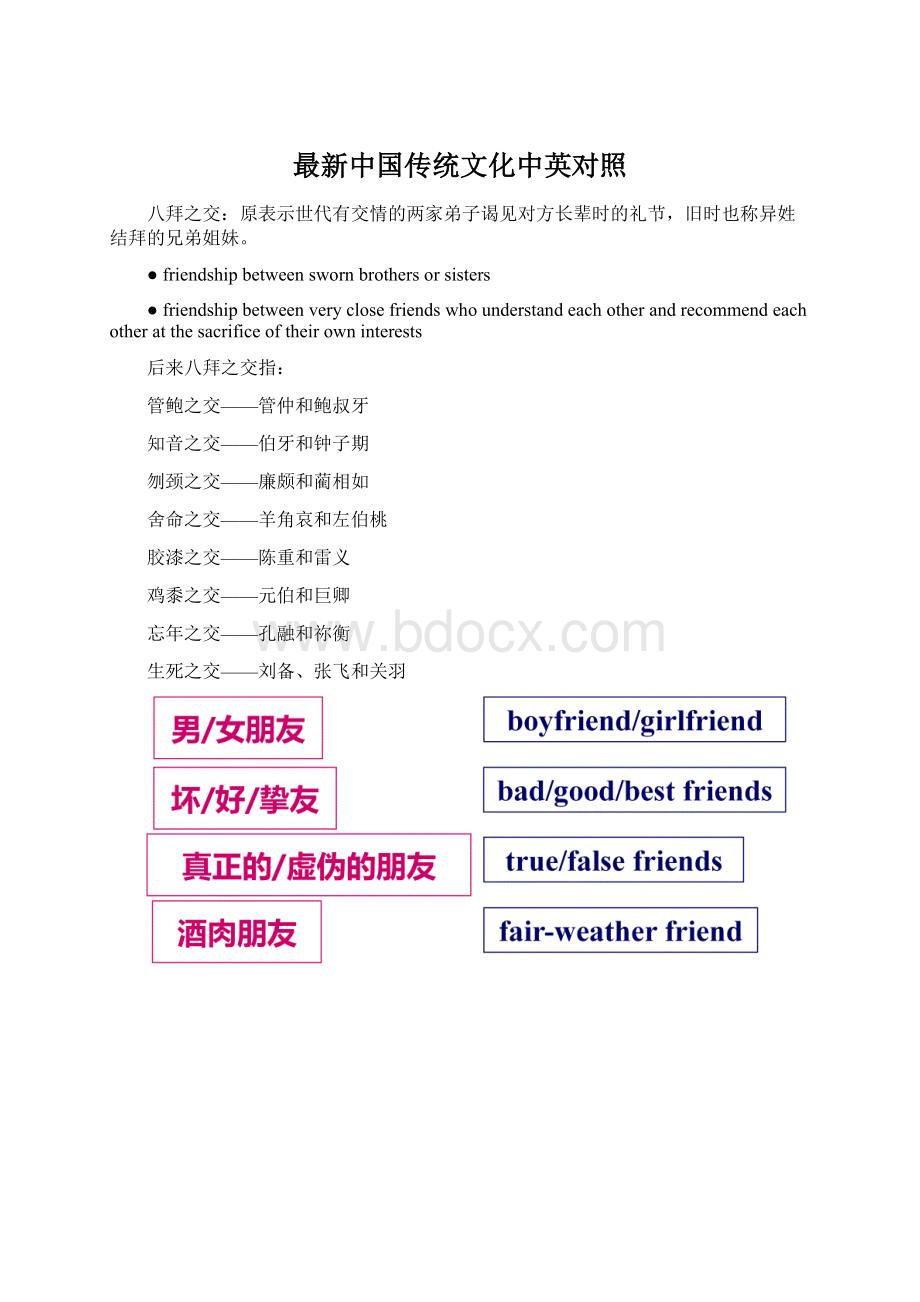 最新中国传统文化中英对照.docx
最新中国传统文化中英对照.docx
- 文档编号:7345971
- 上传时间:2023-01-23
- 格式:DOCX
- 页数:9
- 大小:92.02KB
最新中国传统文化中英对照.docx
《最新中国传统文化中英对照.docx》由会员分享,可在线阅读,更多相关《最新中国传统文化中英对照.docx(9页珍藏版)》请在冰豆网上搜索。

最新中国传统文化中英对照
八拜之交:
原表示世代有交情的两家弟子谒见对方长辈时的礼节,旧时也称异姓结拜的兄弟姐妹。
●friendshipbetweenswornbrothersorsisters
●friendshipbetweenveryclosefriendswhounderstandeachotherandrecommendeachotheratthesacrificeoftheirowninterests
后来八拜之交指:
管鲍之交——管仲和鲍叔牙
知音之交——伯牙和钟子期
刎颈之交——廉颇和蔺相如
舍命之交——羊角哀和左伯桃
胶漆之交——陈重和雷义
鸡黍之交——元伯和巨卿
忘年之交——孔融和祢衡
生死之交——刘备、张飞和关羽
keypal/Internetfriends
莫逆之交:
bosomfriends
总角之交:
friendshipbetweenpeoplewhoarefriendssincechildhood
一般作宾语,指儿时的朋友。
总角:
古代未成年的人把头发扎成髻。
借指童年时期,幼年。
总角是八九岁至十三四岁的少年,古代儿童将头发分作左右两半,在头顶各扎成一个结,形如两个羊角,故称“总角”。
贫贱之交:
friendshipbetweenpeoplewhoarepoverty-strickenandfromhumblecircumstances
杵臼之交:
friendshipbetweenpeoplewhodonotcareaboutthefinancialconditionandsocialstatusofeachother
杵:
舂米的木棒;臼:
石臼。
比喻交朋友不计较贫富和身分。
君子之交:
friendshipbetweengentlemen
小人之交:
friendshipbetweenvillains
狐朋狗友:
peoplewhooftengathertogetherdoingsomethingmeaninglessandevenillegal
棋友/牌友/球友:
peoplewhooftenmeettoplaychess,poker,ball.etc.
战友:
peoplewhogettoknoweachotherwhileservinginthesamearmyunit
普通老百姓交的朋友谓“布衣之交”;
有钱人与没钱人交朋友谓“车笠之交”;
在逆境中结交的朋友称“患难之交”;
吃喝玩乐结交的朋友称“酒肉之交”;
年岁差别大,行辈不同而交情深厚的朋友称“忘年之交”;
幼年相交的朋友称“竹马之交”;
交情深厚的朋友谓“肺腑之交”;
亲密无间的朋友谓“胶漆之交”;
生死与共的朋友谓“生死之交”;
情投意合的朋友称“莫逆之交”;
哪怕砍头也不改变友谊的朋友称“刎颈之交”;
无意中相遇而结成的朋友称“邂逅之交”;
在道义上互相支持的朋友称“君子之交”;
只见过一次面,交情不深的朋友称“一面之交”;
仅点头打招呼,感情不深的朋友称“点头之交”;
平淡而浮泛交往的朋友称“泛泛之交”;
见过面但不熟悉的人称“半面之交”;
旧时结拜的兄弟姊妹称“八拜之交”;
交友不嫌贫贱称“杵逆之交”;
宝贵而有价值的交往称“金玉之交”。
儒家思想Confucianism
儒家文化Confucianculture
道教Taoism
墨家Mohism
法家Legalism
佛教Buddhism
孔子Confucius
孟子Mencius
老子LaoTzu
庄子ChuangTzu
墨子MoTzu
孙子SunTzu
象形文字pictographiccharacters
《大学》TheGreatLearning
《中庸》TheDoctrineoftheMean
《论语》TheAnalectsofConfucius
《孟子》TheMencius
《孙子兵法》TheArtofWar
《三国演义》ThreeKingdoms
《西游记》JourneytotheWest
文房四宝theFourTreasuresoftheStudy
(笔墨纸砚)(brush,inkStick,paper,andinkstone)
《红楼梦》DreamofRedMansions
《水浒传》HeroesoftheMarshes
《山海经》TheClassicofMountainsandRivers
《资治通鉴》HistoryasaMirror
《春秋》TheSpringandAutumnAnnals
《史记》HistoricalRecords
《诗经》TheBookofSongs
《易经》TheBookofChanges
《礼记》TheBookofRites
《三字经》Three-characterScriptures
八股文eight-partessay
五言绝句five-characterquatrain
七言律诗seven-characteroctave
(一)Chinesecharacterswereinitiallymeanttobesimplepicturesusedtohelppeoplerememberthings.Afteralongperiodofdevelopment,itfinallybecameauniquecharactersystemthatembodiesphoneticsound,image,idea,andrhymeatthesametime.Thewritingsystem,whichwasextremelyadvancedinancienttimes,beganwithinscriptionsonbonesandtortoiseshells,andtheseareregardedastheoriginalformsofChinesecharacters.Afterwards,Chinesecharacterswentthroughnumerouscalligraphicstyles:
bronzeinscriptions,officialscript,regularscript,cursivescript,runningscript,etc.Chinesecharactersareusuallyroundoutsideandsquareinside,whichisrootedinancientChinesebeliefsofanorbicularskyandarectangularEarth.ThefivebasicstrokesofChinesecharactersare“---“(thehorizontalstroke)“│”(theverticalstroke),“/”(theleft-fallingstroke),“\”(theright-fallingstroke),and“乙”(theturningstroke).
汉字是从原始人用以记事的简单图画,经过不断演变发展最终成为一种兼具音、形、意韵的独特文字。
现存中国古代最早成熟的文字是甲骨文,被认为是现代汉字的初形。
此后,汉字又经历了金文、隶书、楷书、草书、行书等不同的阶段。
汉字结构“外圆内方“,源于古人”天圆地方“的观念。
汉字有五种基本笔画,即:
横、竖、撇、捺、折。
(二)ChineseTaoismTaoismfirstoriginatedinChina.ThefounderofTaoismisLaozi,aphilosopherandthinkerwholivedinthelateSpringandAutumnPeriod(770BC-476BC).TaoTeChingwhoseauthorshiphasbeenattributedtoLaozi,isconsideredtobethemainTaoistclassic.Taoismadvocatesthevalueofahumanbeing’slife,recommendsthediscardingofalldesiresandworriesfromone’smind,andencouragesthecultivationofmoralcharacterandthenourishmentofhumannature.ThefollowingisanexampleofLaozi’sgoldensaying:
Thewaythatcanbetoldofisnotanunvaryingway;thenamesthatcanbenamedarenotunvaryingnames.ItwasfromthenamelessthatHeavenandEarthsprang;Thenamedisbutthemotherthatrearsthetenthousandcreatures,eachafteritskind.Truly,onlyhethatridshimselfforeverofdesirecanseethesecretessences;Hethathasneverridhimselfofdesirecanseeonlytheoutcomes.
道教是中国土生土长长的宗教。
创始人是春秋末期的哲学家、思想家老子。
道教以老子所著的《道德经》为主要经典。
道教主张“重人贵生”。
崇尚清静无为,修身养性。
“道可道,非常道。
名可名,非常名。
无名天地之始;有名万物之母。
故常无,欲以观其妙;常有,欲以观其徼”便是老子的至理名言。
(三)TheFourTreasuresoftheStudyThewritingbrush,inkstick,inkstone,andpaperwererequisitetreasuresinthestudyofthescholarsofancientChina,andtheyareoftenreferredtoasthe“FourTreasuresoftheStudy.”ThewritingbrushandinkstickhavebeenusedbytheChinesetowriteandpaintsince5,000yearsago.IntheQinDynasty(221BC---206BC),peoplealreadyusedfeathersofdifferenthardnessandbambootrunkstomakebrushes.DuringtheHanDynasty(206BC-220AD),man-madeinkwasusedinsteadofnaturalink.AfterpaperwasinventedbytheChinese,bambooslips,woodentablets,brocadeandsilk,whichoriginallyfunctionedaswritingsurfaces,graduallyfadedout.Theinkstonewasfirstdevelopedwiththeuseofwritingbrushesandink.AftertheSongDynasty(960AD---1279AD),the“FourTreasureoftheStudy”particularlyreferredtohubi,thewritingbrushproducedinHuzhou,Zhejiangprovince;huimo,theinkstickproducedinHuizhou,Anhuiprovince;xuanpaper,akindofpaperproducedinXuanzhou,Anhuiprovince;andduanyan,theinkstonemadeinZhaoqing,Guangdongprovince(ZhaoqingwasearliercalledDuanzhou).Indeed,theFourTreasuresoftheStudy”havewrittenthewholeChinesecivilization,asitis.
笔墨纸砚是中国古代文人书房当中必备的宝贝,被称为“文房四宝”。
用笔墨书写绘画在中国可追溯到五千年前。
秦时已用不同硬度的毛和竹管制笔;汉代以人工制墨替代了天然墨;有了纸张以后,简牍锦帛逐失其用;砚台则随笔墨的使用而发展。
“文房四宝”到宋朝以后特指湖笔、徽墨、宣纸、端砚。
可以说文房四宝书写了整个中华文明。
(四)ChineseIdiomsChineseidiomsrefertocomprehensiveandintegratedfixedphrasesandexpressions.Idiomsareestablishedandacceptedbyconstantusageandcommonpractice.Anidiomisalanguageunitthatislargerthanaword,buthasthesamegrammaticalfunctionasaword.MostChineseidiomsconsistoffourcharacters.Forexample,ziqiangbuxi(makeunremittingeffortstoimproveoneself),qingchuyulan(bluerthanindigo),andhoujibofa(successcomeswithtimeandeffort).Idiomsareextractedfromfolkproverbs,ancientworksofliterature,poems,fables,allusions,andwell-knownsayings.IdiomsareapartoftheChineselanguagethatareconciseandhavegreatvitality.
中国成语是汉语中意义完整的表示一般概念的固定词组或短语。
“成语”中的“成”既是约定俗成。
成语是比词大而语法功能又相当于词的语言单位。
绝大多数的中国成语由四个汉字组成,例如:
自强不息、青出于蓝、厚积薄发。
成语主要从民间谚语、古代文学作品、诗歌、寓言、典故、名言警句等方面提炼而成,是汉语语言中精炼而又富有生命力的一部分。
(五)ChineseSealAsealcanalsobedefinedasastamp.BoththeChineseofficialandprivatesealofvariousdynastieshavedifferenttitles,suchasstamp,zhunote,contract,fu,leaseandothers.ThesealsusedbytheemperorsofancientChinawerecalledxi,yin,bao,etc.Accordingtohistoricalrecords,sealswerewidelyusedduringtheWarringStatesPeriod(475BC-221BC).Themakingofasealistoengravefonts,suchassealcharactersandofficialscriptandsoon;orimagesintheformofintaglioandembossmentintotheseal,basicallyshapedasroundorsquare.Coveredwithavermilionoverlay,theChinesesealisnotonlyusedindailylife,butitisalsousedtorepresentsignaturesonpaintingsandcalligraphies.ItisgraduallybecomingoneofChina’suniqueartworks.
印章就是图章。
中国历代官、私所用的印章有印信、朱记、合同、符、契等等不同的称谓,而帝王所用的印章古时称玺、印、宝、章等。
据史料记载,印章在战国时代已普遍使用。
印章的制作是将篆隶等字体、图像用阴、阳的形式雕刻而成,形状以圆、方为主。
印章用朱色钤盖,除日常应用外,又多用于书画题识,逐渐成为中国特有的艺术形式之一。
八年级下册第一次月考生物试题
一、选择题(本题20小题,每小题1分,共20分。
各小题只有一个选项正确,请将正确答案填在题后的答题栏中)
1.据科学推测,原始大气中没有下列哪种气体物质
A.水蒸气
B.氢气C.二氧化碳D.氧气
2.美国科学家米勒等人所做的化学进化模拟实验,支持了生命起源过程的
A.无机物→有机小分子阶段B.有机小分子→有机大分子阶段
C.有机大分子→独立体系阶段D.独立体系→原始生命阶段
3.下列有关人类起源和进化的叙述中,错误的是( )
A、森林古猿就是类人猿B、人类进化是一个自然选择的过程
C、人类的祖先是森林古猿 D、现代类人猿与人类有共同祖先
4.按照生命起源的化学进化学说,原始生命诞生的场所是()
A.原始大气B.原始海洋C.原始森林D.原始陆地
5.2005年8月,“国际黑猩猩基因测序与分析联盟”宣布,黑猩猩与人类在基因上的相似程度达到96%以上。
这个事例可以说明
A.人类和黑猩猩的共同祖先是森林古猿B.人类是由黑猩猩经过漫长的年代进化而来的
C.人类和黑猩猩有较近的亲缘关系D.生物具有遗传和变异的特性
6.由于某种原因,使森林中几乎所有的树木颜色都变成了灰白色。
长期的自然选择使得该森林中不同颜色的蛾的相对数量发生了变化,下列各项中最能表示这一变化结果的是
7.越古老的地层中,化石中的生物()
A.越低等,越简单B.越高等,越复杂
C.个体越大D.陆生种类越多
8.长颈鹿的颈很长,按照达尔文的观点,其原因是()
A.变异朝着有利于生殖的方向发展的结果B.繁衍后代的需要
- 配套讲稿:
如PPT文件的首页显示word图标,表示该PPT已包含配套word讲稿。双击word图标可打开word文档。
- 特殊限制:
部分文档作品中含有的国旗、国徽等图片,仅作为作品整体效果示例展示,禁止商用。设计者仅对作品中独创性部分享有著作权。
- 关 键 词:
- 最新 中国传统文化 中英对照
 冰豆网所有资源均是用户自行上传分享,仅供网友学习交流,未经上传用户书面授权,请勿作他用。
冰豆网所有资源均是用户自行上传分享,仅供网友学习交流,未经上传用户书面授权,请勿作他用。


 如何打造酒店企业文化2刘田江doc.docx
如何打造酒店企业文化2刘田江doc.docx
